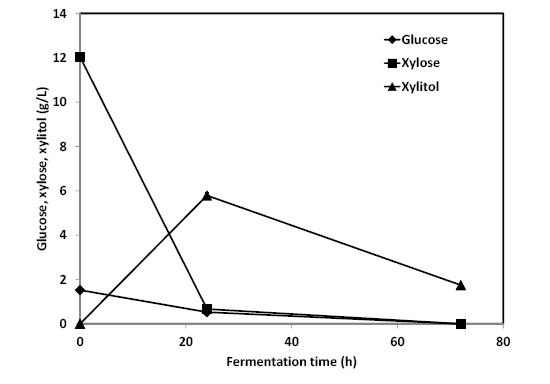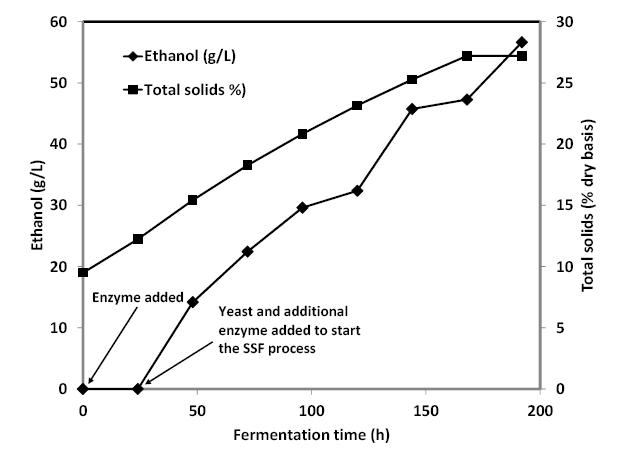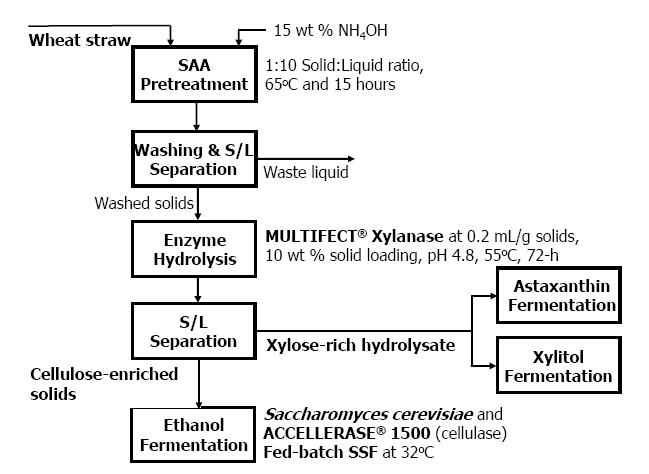Mention of trade names or commercial products in this article is solely for the purpose of providing specific information and does not imply recommendation or endorsement by the U. S. Department of Agriculture. USDA is an equal employment provider and employer.
1. Introduction
Ethanol has attracted considerable attention worldwide as a clean and renewable liquid fuel. The two main feedstocks currently used successfully for commercial ethanol production are corn and sugarcane. However, to meet the projected demand for ethanol other sources of fermentable sugars are needed. In attempts to reach this objective significant efforts have been made to develop technologies for production of ethanol from lignocellulosic feedstocks (LCF), which are available in very large quantities. Whereas in the U.S. corn stover is considered the most important LCF wheat straw is its counterpart in other regions such as Europe and Asia. In 2012, the total world production of wheat was 671 million metric tons (MT), of which 196 million MT (i.e. 29.2% of total world production) was produced in Europe and 311 million MT (i.e. 46.4% of total world production) was produced in Asia. China is the largest wheat producer in the world. In 2012 China produced 121 million MT of wheat, which accounted for 18% of the total world production [1]. Using a residue/crop ratio of 1.3 kg straw per kg grains [2] and assuming 30% straw will be left behind for prevention of soil erosion [3], the quantity of wheat straw that could be sustainably recovered globally in 2012 would be 611 million MT. Wheat straw typically contains 39.6 wt% cellulose and 26.4 wt% hemicellulose on a dry basis [4]. Thus, about two-third of the total mass of wheat straw can be converted biochemically to useful products. Because of its potential as a very important LCF many studies have been performed on bioconversion of wheat straw to ethanol [5,6,7,8,9,10]. Conversion of a LCF to ethanol as the only major product is a very expensive process, which requires large capital investments. In addition, the microorganisms that have been developed for fermentation of both C5 and C6 sugars derived from a LCF to ethanol have many disadvantages such as low ethanol tolerance and yields. Thus, the concept of a LCF biorefinery has recently been proposed. The products of a LCF biorefinery include ethanol and value-added products. In the LCF biorefinery instead of fermenting both C5 and C6 sugars to ethanol only glucose is used for ethanol production whereas the C5 sugars are used for production of other products. Aside from the potential economic benefit of generating a suite of products with higher profit margins than ethanol, a major technical advantage is, with glucose as the substrate, the yeast Saccharomyces cerevisiae, which is the most efficient commercial ethanol-producing organism, can be used to carry out the fermentation. The biorefinery process recently developed at the Eastern Regional Research Center (ERRC) using wheat straw as feedstock is described in this report. The proposed conversion process for wheat straw consisted of the following steps:
1. Pretreatment of wheat straw to improve subsequent enzyme hydrolysis.
2. Hydrolysis of the pretreated wheat straw by a commercial hemicellulase to produce a xylose-rich stream and a cellulose-enriched solid residue.
3. Conversion of the xylose-rich stream to value-added products using suitable microorganisms.
4. Simultaneous saccharification and fermentation (SSF) of the cellulose-enriched residue using a commercial cellulase and the yeast S. cerevisiae.
In the proposed integrated process, soaking in aqueous ammonia (SAA) was used for the pretreatment of wheat straw. This pretreatment technique was selected because it has been demonstrated with several lignocellulosic feedstocks such as barley hull [11], barley straw [12], and corn stover [13,14,15] in which high preservation of cellulose and hemicellulose in the pretreated solids, i.e. greater than 90% and 80% of the original quantities for cellulose and hemicellulose, respectively, was observed. Production of astaxanthin and xylitol was used to illustrate the feasibility of using the xylose-rich stream for production of value-added products. Astaxanthin is a high-value specialty product, which has been recognized as one of the potential co-products of ethanol fermentation [16]. Currently the major application of this carotenoid is for use in feed products to give the flesh of farm-raised fish such as salmon the pinkish-red hue similar to those in the wild. Astaxanthin recently has been found to possess many human health benefits [17,18]. These discoveries could lead to development of nutraceutical applications and significant expansion of the market for astaxanthin and thus high demand for natural astaxanthin products [19]. Synthesis of astaxanthin by the yeast Phaffia rhodozyma using lignocellulosic sugars such as those derived from corn fiber has previously been demonstrated [20]. Xylitol is a rare sugar with applications in the food, chemical, and pharmaceutical industries as a sweetener, a raw material for the production of other rare sugars, or an anti-cavity compound in dental products. It is currently manufactured chemically by catalytic hydrogenation of xylose. Due to the costly nature of the process, however, biotechnological production methods are being investigated [21]. Yeasts, particularly strains of Candida, are considered good candidates for the fermentative production of xylitol. Candida naturally utilizes xylose to produce xylitol in high yield. Recombinant S. cerevisiae has been engineered with the ability to produce xylitol from xylose in yields similar to those achieved in Candida, but their productivity is much lower (Granströ m et al. 2007). Xylose-containing biomass hydrolysates have been suggested as a renewable feedstock for biotechnological xylitol production (Rivas et al. 2009).
2. Materials and Method
2.1. Materials
Pioneer 34R65 wheat straw was harvested at Hougar Farms, Coatesville, Pennsylvania in 2012 and kindly donated to the Sustainable Biofuels and Co-Products Research Unit at the ERRC for research purposes. The straw was stored in a low-humidity room at ambient temperature (18-24 ℃) and relative humidity below 25%. Prior to pretreatment the straw was ground and screened. The fractions that passed through the 1 mm screen were collected and air-dried at room temperature (25 ℃) for use in the experiments. The initial composition of the collected wheat straw was 34.5 wt% glucan, 19.3 wt% xylan, 3.0 wt% arabinan, 22.3 wt% lignin (acid insoluble + acid soluble), and 2.6 wt% ash. The procedures used for compositional analysis of the barley straw are described in the section on analytical methods.
P. rhodozyma strain ATCC 74219 (UBV-AX2), which is a high astaxanthin-producing industrial strain, was obtained from the American Type Culture Collection (Manassas, VA). The freeze-dried culture was reconstituted in 25 ml of yeast malt (YM) media in a 250-ml flask. Following incubation at 22 ℃ and 250 rpm for two days, 20 ml of the broth was mixed with 10 ml of sterile glycerol, and stock culture vials were stored at -70 ℃. Candida mogii NRRL Y-17032, which is a xylitol-producing organism, was obtained from the U.S. Department of Agriculture’s National Center for Agricultural Utilization Research (Peoria, IL). The freeze-dried culture was reconstituted in a similar manner as described for the P. rhodozyma freeze-dried culture, except that the incubation temperature and time were 30 ℃ and one day, respectively. Active Dry Ethanol Red yeast culture (S. cerevisiae) was provided by Lesaffre Yeast Corporation (Milwaukee, WI). The biomass enzyme products ACCELLERASE® 1500 and MULTIFECT® Xylanase were kindly provided by DuPont Industrial Biosciences (Palo Alto, CA). ACCELLERASE® 1500 contained mainly exo- and endo-glucanase, hemicellulase, and β-glucosidase. The reported average endo-glucanase activity was 2875 carboxymethyl cellulose (CMC) units/ml. The reported average β-glucosidase activity was 745 para-nitrophenyl-β-D-glucopyranoside (pNPG) units/ml. The reported activity of MULTIFECT® Xylanase was 8000 Genencor xylanase units (GXU)/ml. All chemicals were of reagent grades and purchased from various suppliers.
2.2. Methods
2.2.1. Wheat straw pretreatment and hydrolysis
Ground wheat straw was pretreated in a closed container using 700 ml of 15 wt% NH4OH (i.e. a solid:liquid ratio of 1:10) at 65 ℃ for 15 h. The pretreated solids were recovered by vacuum filtration and washed with deionized (DI) water until the pH of the wet cake was about 7. Approximately 4.5 liters of DI water was needed for washing of 100 g starting material. Several batches of wheat straw were pretreated as described. To prepare the xylose-rich hydrolysate the pretreated wheat straw was hydrolyzed with MULTIFECT® Xylanase at 0.2 ml/g dry biomass in 50 mM citrate buffer at pH 4.8. The solid loading was 10 wt% (dry basis). The hydrolysis was performed with 107 g (dry basis) pretreated wheat straw in 963 g buffer a 2.5-liter BIOFLO® 410 fermentor (New Brunswick Scientific, Edison, NJ) maintained at 55 ℃ and agitated at 250 rpm for 72 h. The residual solids were recovered by vacuum filtration, dried in a 55 ℃ oven, and ground with a small coffee grinder (Krups, model F 203, Medford, MA) for further processing. The hydrolysate was stored frozen until use.
2.2.2. Astaxanthin fermentation
Astaxanthin production using the wheat straw hydrolysate was performed in 250-ml flasks. Amberex 695 AG yeast extract was added to the hydrolysate at 5 g/l to provide the required nutrients. The nutrient-enriched medium then was adjusted to pH 5 with 2 M H2SO4 and transferred to the flasks at 25 ml/flask. The inoculum was prepared in YM medium (21 g/l). Each 250-ml flask containing 25 ml YM medium was inoculated with 0.5 ml thawed glycerol stock culture. The inoculum medium was sterilized by autoclaving at 121 ℃ for 20 minutes whereas the fermentation medium was filter-sterilized. The inoculum flask was incubated at 22 ℃ and 250 rpm for 3 days before 1 ml culture was used to inoculate the production flasks. Following inoculation the production flasks also were incubated at 22 ℃ and 250 rpm. Samples were taken at intervals for astaxanthin and sugar analysis. The astaxanthin production experiment was performed in triplicate and the average results are reported.
2.2.3. Xylitol fermentation
Xylitol production experiment was performed in a similar manner using the same nutrient-enriched hydrolysate as described for astaxanthin fermentation. The only differences were: 1. The pH of the medium was adjusted to 6.5; 2. The inoculum flask was inoculated with 0.2 ml thawed glycerol stock culture and the culture was grown for 24 hours prior to inoculation of the production flasks; and 3. The inoculum and production flasks were incubated at 30 ℃. The xylitol production experiment was performed in duplicate and the average results are reported.
2.2.4. Ethanol fermentation
Fermentation of the cellulose-enriched residue was performed using a fed-batch SSF protocol. The dried residue was ground in a small coffee grinder for two minutes prior to use in the fermentation experiment. The first day of the experiment was dedicated solely to enzyme hydrolysis. Thus, 2.00 g cellulose-enriched residue was added to a 250-ml flask containing 18.5 ml 50 mM citrate buffer at pH 4.8, which was previously sterilized by autoclaving at 121 ℃ for 20 minutes. Next, 500 μl ACCELLERASE® 1500 was added. The flask was securely capped with a rubber stopper and incubated at 50 ℃ and 250 rpm. After 24 hours a 0.5 ml sample was removed from the flask. The sample was centrifuged on a microcentrifuge (Eppendorf, model 5415D, Hauppauge, NY) for 3 minutes. The supernatant was filtered using a 0.2-micron syringe filter and saved for sugar analysis. The solid pellet was recovered from the microcentrifuge tube with a small spatula and added back to the flask. A volume of citrate buffer equal to the volume of the removed supernatant was also added to the flask. After the sampling was completed, the following were added to the flask: 1.00 g cellulose-enriched residue, 375 ml ACCELLERASE® 1500, and 1.0 ml stock solution of Amberex 695 AG yeast extract containing 191.5 g/l, which was previously sterilized as described for the citrate buffer. The inoculum was prepared by suspension of 0.25 g Dry Ethanol Red yeast powder in 5 ml buffer and stirring for 30 minutes. The SSF was initiated by addition of 1.0 ml yeast culture to the flask. The flask was capped with a rubber stopper which had an 18-gauge hypodermic needle punctured through to provide pressure relief for the CO2 produced. The flask finally was incubated in a shaker maintained at 32 ℃ and 175 rpm. Progress of ethanol fermentation was followed by weight loss due to production of CO2. Every day 1.00 g cellulose-rich residue and 375 ml ACCELLERASE® 1500 were added to the flask. An Excel spreadsheet was set up to calculate ethanol concentrations using the weight loss data. At the end of the experiment a final sample was removed from the flask and processed as described previously for analysis of residual sugars, ethanol, and other metabolites. The SSF experiment was performed in duplicate and the average results are reported.
2.2.5. Analytical methods
Astaxanthin was determined as total carotenoid with pure astaxanthin used as standard as described previously [20]. Samples taken for analysis of other metabolites were centrifuged on a microcentrifuge and the supernatants were filtered through a 0.2 μm filter. The metabolites were analyzed by HPLC as described previously [20]. The carbohydrate contents of the wheat straw were determined by the NREL method [24].
3. Results
3.1. SAA-pretreatment of wheat straw
The results of compositional analysis of the untreated and SAA-treated wheat straw are shown in Table 1. The results are given as percentages of the total mass on a dry basis. The compositions of the SAA-treated wheat straw are given as is (last column) and also are normalized to 100 g of the untreated material (middle column). It can be seen that the pretreatment of wheat straw with aqueous ammonia resulted in high degree of delignification. Almost 50% of the original lignin (acid soluble plus acid insoluble) was removed. High degree of delignification during SAA pretreatment would result in improvement of enzymatic hydrolysis of the pretreated lignocellulosic material as previously observed, for example, for barley straw [25]. In contrast to lignin the carbohydrate fractions in the barley straw were highly preserved during the pretreatment. In the pretreated solid, 99% of the original glucan and 83% of the original xylan were retained. Retention of arabinan was lower at 77% of the original amount. The net result of lignin removal and carbohydrate retention was increases in glucan and xylan contents of the pretreated solid over those values in the original material. The glucan content increased from 34.5 wt % to 46.3 wt % and the xylan content increased slightly from 19.3 wt% to 21.9 wt%. The arabinan content of the pretreated wheat straw was unchanged and stayed at 3 wt%.
Table 1. Recovery and composition of SAA-treated wheat straw
Notes: 1. n: number of replicates; AIL: acid insoluble lignin; ASL: acid soluble lignin; SR: Solid remaining after pretreatment.
2. The compositions of the SAA-treated wheat straw based on dry untreated solid were calculated from data on solid recovery and compositions of the treated wheat straw determined experimentally. For example, glucan content of the SAA-treated wheat straw based on dry untreated solid = (46.3 × 73.4) ÷ 100 = 34.0%. |
| Based on dry untreated solid | | Based on dry treated solid |
| Components | Untreated wheat straw | | | | SAA-treated wheat straw |
| SAA-treated wheat straw | |
| [wt. %] | | [wt. %] | | [wt. %] |
| Glucan | 34.5 | | 34.0 | | 46.3 |
| Xylan | 19.3 | | 16.1 | | 21.9 |
| Arabinan | 3.0 | | 2.3 | | 3.1 |
| AIL | 20.8 | | 10.9 | | 14.8 |
| ASL | 1.5 | | 0.7 | | 1.0 |
| n | 3 | | 2 | | 2 |
| SR | 100 | | 73.4 | | |
3.2. Xylanase hydrolysis of SAA-treated wheat straw
At the end of the xylanase hydrolysis of the SAA-treated wheat straw, 89.1 g residual solid was collected. The carbohydrate contents of the solid residue were 53.0 wt% glucan, 16.7 wt% xylan, and 2.2 wt% arabinan. The hydrolysate contained 1.3 g/l glucose, 14.1 g/l xylose, and 1.7 g/l arabinose. Since the pretreated barley straw contained 21.9 wt% xylan the theoretical yield of xylose upon complete hydrolysis would be 26.6 g (107 g solid x 0.219 g xylan/g solid x 1.136 g xylose/g xylan). The total amount of xylose released in the hydrolysate was 13.9 g or 52% of the theoretical value. Similarly, 49% of the theoretical arabinose yield was obtained in the hydrolysate. Since one of the objectives was to maximize the yields of xylose and arabinose in the hydrolysate for use in subsequent production of value-added products, further experiments would be needed to improve the enzyme hydrolysis to accomplish this goal. The other objective was to preserve glucan in the residual solids for ethanol fermentation by the yeast S. cereviciae. Of the 55.0 g theoretical yield of glucose in the pretreated barley straw (107 g solid ×0.463 g glucan/g solid × 1.111 g glucose/g glucan), only 1.3 g or about 2% was released in the hydrolysate. Thus, 98% of the glucan content of the pretreated barley straw was preserved for subsequent ethanol production by S. cerevisiae. In summary, the results obtained in this part of the study demonstrated the feasibility of using a suitable commercial enzyme product with high hemicellulase activity for fractionation of pretreated barley straw into xylose-rich and glucose-rich fractions for subsequent conversion to value-added products and ethanol, respectively.
3.3. Production of value-added products
The results of astaxanthin fermentation are shown in Figure 1. The results clearly demonstrated that the wheat straw hydrolysate was a good fermentation medium for astaxanthin production. It was observed in previous investigation that high glucose concentrations suppressed utilization of other sugars by P. rhodozyma [20]. The hydrolysate obtained by hydrolysis of the SAA-treated wheat straw contained very low glucose concentrations, thus, qualified itself for a suitable fermentation medium for conversion of xylose to astaxanthin. The final yield was 1.98 mg astaxanthin/g total sugars consumed, which was similar to the yield observed previously [20].
The results of xylitol fermentation are shown in Figure 2. The results again demonstrated the suitability of the hydrolysate obtained from the SAA-treated wheat straw for production of xylitol, similar to the case of astaxanthin. Xylitol was produced at relatively high rates and reached 5.8 g/l after the first day. However, when both substrates (glucose and xylose) were depleted some of the xylitol produced was consumed probably for cell growth and maintenance via the pentose-phosphate pathway [26]. Xylitol consumption by C. mogii upon substrate depletion is an important factor that should not be overlooked in development of fermentation processes for its production. The maximum xylitol yield was 0.51 g/g xylose consumed, which is similar to the value observed by others [26].
3.4. Production of ethanol
The results of the fed-batch SSF of the cellulose-rich solid residue are shown in Figure 3. As discussed previously, these results were calculated using the actual data on weight loss due to CO2 production. At the end of the first 24-hour period during which the hydrolysis was performed at the optimum temperature of the enzyme the concentration of glucose in the liquid was 23.4 g/l, which was equivalent to 51% of the theoretical yield. As expected, the availability of readily fermentable glucose allowed ethanol production to proceed at high rates during the first day after the SSF was initiated. The ethanol production rate then dropped by about 40% on the next day, presumably due to near exhaustion of the initial glucose. The rate then continued to decrease, but only gradually. The final solid loading was 27.2 wt% and the final ethanol concentration calculated from the weight loss data was 56 g/l. The final ethanol yield was equivalent to 63% of the theoretical value, based on the glucan content of the cellulose-enriched solid residue. Recovery of ethanol by distillation is a very energy-intensive process, thus a major item of the overall operating costs, especially for dilute ethanol solutions. Normally the target for cellulosic ethanol fermentation is 50 g/l since at this concentration the benefit of distillation energy reduction with respect to increase in ethanol concentration starts to become less significant [27]. The final ethanol concentration achieved in the fed-batch SSF of the cellulose-enriched solids was above that target. The average concentrations of glucose and xylose in the final samples were 2.0 g/l and 17.9 g/l, respectively. Low glucose concentrations indicated a highly efficient SSF process. The yeast strain used in this experiment was capable of metabolizing only glucose, thus resulting in accumulation of xylose. Even without xylose conversion, to the best of our knowledge, the final ethanol concentration obtained in this work was still among the highest values reported for biochemical conversion of lignocellulosic biomass to ethanol.
4. Discussion
The simplified process flow diagram (PFD) of the wheat straw biorefinery is shown in Figure 4. In this process, wheat straw first is pretreated by the SAA or other ammonia-based process that remove lignin but preserve most of the carbohydrate fractions. The pretreated material is hydrolyzed with a commercial hemicellulase product to provide a solution rich in xylose and low in glucose. This solution then is used for production of value-added products in fermentation processes. In this investigation we demonstrated the production of two such products, i.e. xylitol and astaxanthin. However, other industrially chemicals can also be produced using the xylose-rich solution and suitable microorganisms. The residue obtained after the enzymatic hydrolysis of the pretreated straw, in which the glucan contents have been concentrated by extraction of lignin in the pretreatment step and conversion of xylan to xylose in the hydrolysis step, is used for ethanol production in a fed-batch SSF process. In this process, a commercial cellulase product is used for hydrolysis of the glucan in the residue and the yeast S. cerevisiae, which is the most efficient commercially suitable ethanol-producing organism, is used for ethanol production.
5. Conclusion
An integrated process for production of ethanol and industrial chemicals in a wheat straw biorefinery has been demonstrated. Astaxanthin and xylitol were selected as examples of value-added products of the biorefinery. Other industrial chemicals can be made from the xylose-rich solution by using suitable microorganisms. Fuel ethanol could be produced from the cellulose-enriched solids in a fed-batch SSF process to reach final concentrations above 50 g/L. The results shown here are only the proof of concept for the integrated process. Further process development and optimization followed by process validation in pilot plants are needed before the developed process can be implemented in commercial practice.
Acknowledgments
The authors would like to thank Justin Montanti, Gerard Senske and Jennifer Thomas for their assistance with sample analysis. The critical review of the manuscript by Dr. Bruce Dien is greatly appreciated. The authors also would like to thank Hougar Farms in Coatesville, Pennsylvania for providing the wheat straw and DuPont Industrial Biosciences for providing the enzyme products used in this study. Dr. Xiu Zhang was supported by a fellowship under the State Scholarship Fund from the China Scholarship Council (CSC) administered by the government of the People’s Republic of China during his tenure as a Visiting Scientist at the Eastern Regional Research Center.
Conflict of Interest
The authors declare there is no conflict and interest.









 DownLoad:
DownLoad: 










